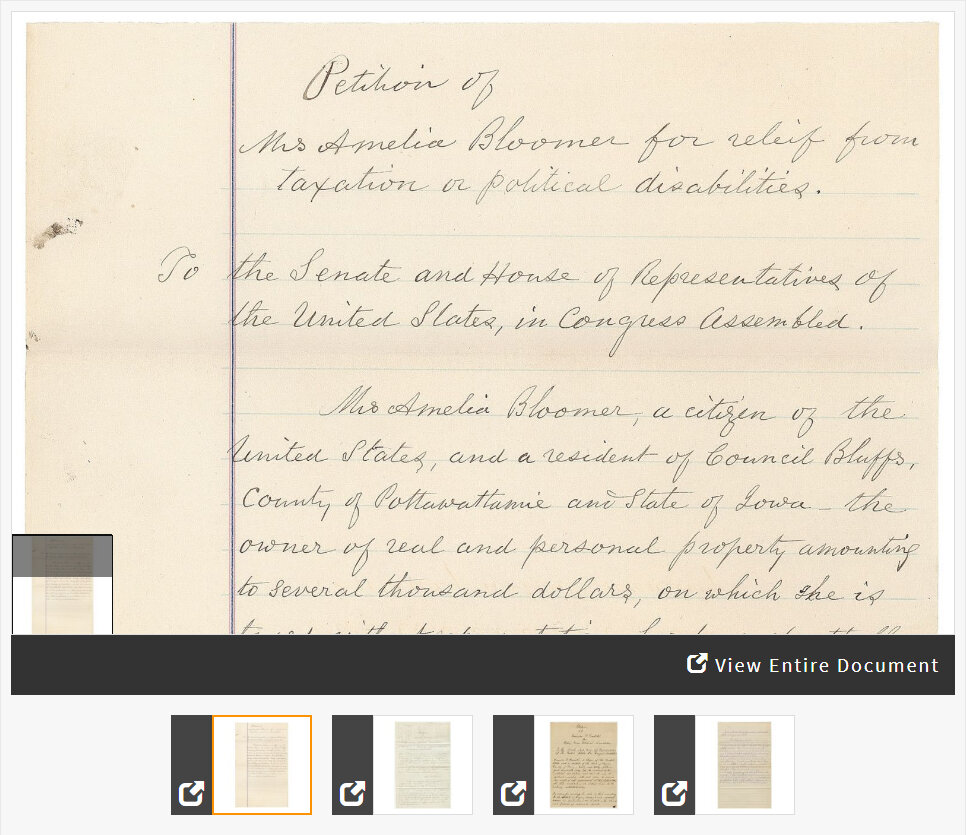Students will compare and contrast four petitions in favor of woman suffrage to identify reasons why women wanted the right to vote.
Suggested Teaching Instructions
This activity can be used in a U.S. history course while learning about women's suffrage. It is intended for grades 9-12. The approximate time needed is 45 minutes. Students can work individually or in small groups. For small group work, each student can analyze one of the four petitions and then work as a group to answer the discussion questions. Instead of having students submit their responses to you, you may wish to conduct the "When You're Done" section as a full class discussion.
Ask students to examine the four petitions. For each petition, students will need to determine:
- Who wrote it?
- Who received it?
- Where is it from?
- What is it about?
Remind students that they can view a transcript of each petition by clicking on
View Entire Document below the image. On the page that opens, scroll down and click
Show Transcript. After they have analyzed each petition, students will answer the following questions:
- What do you think the phrase "removal of her political disabilities" means?
In these petitions, the phrase "political disabilities" refers to women's status as nonvoting citizens. It may be helpful to ask students to consider how being denied the right to vote could be seen as a political disability. How does it impair women's status in society?
- Compare and contrast the documents. Are there any similarities among the documents?
Students should notice that the petitions are all to Congress, generally seem to follow the same format, and include the same line "...hereby respectfully petitions your honorable body for the removal of her political disabilities, and that she may be declared invested with full power to exercise her right of self-government at the ballot-box, all state constitutions or statute laws to the contrary notwithstanding."
- What are the different reasons women provide for wanting the right to vote?
Answers should include:
- Taxation without representation (Amelia Bloomer, Eliza Jane Christie)
- Laws made by men for women can be unjust and one-sided (Ann Hosmer)
- Righteous government cannot exist without equal rights for all (Ann Hosmer)
- Without the right to vote, women are classed with minors and people of unsound mind (Lucinda Proebstel)
- Women have political views that they want represented (Eliza Jane Christie)
Next, students are asked to review the petition of Clemence Lozier and answer the following questions:
- How does the petition of Clemence Lozier add to our understanding of the petitions in this activity?
This petition shows that the similar language and formatting of the petitions in this activity came from a template provided by the National Woman Suffrage Association.
- Why do you think the National Woman Suffrage Association encouraged women to personalize their petitions to Congress?
Answers may vary, but students should reflect on the persuasive quality of personal experiences and stories of women who were denied the right to vote.
Finally, students are encouraged to keep exploring digitized petitions for women's suffrage and against women's suffrage.
This activity was created using petitions from the records of Congress. The Center for Legislative Archives—part of the National Archives—maintains some of the most historically valuable documents created by the federal government: the records of the U.S. House of Representatives and the U.S. Senate.
Educators can use these historical documents to teach about representative democracy, how Congress works, and the important role Congress has played throughout American history.
Find more resources and lesson plans from the Center for Legislative Archives.





